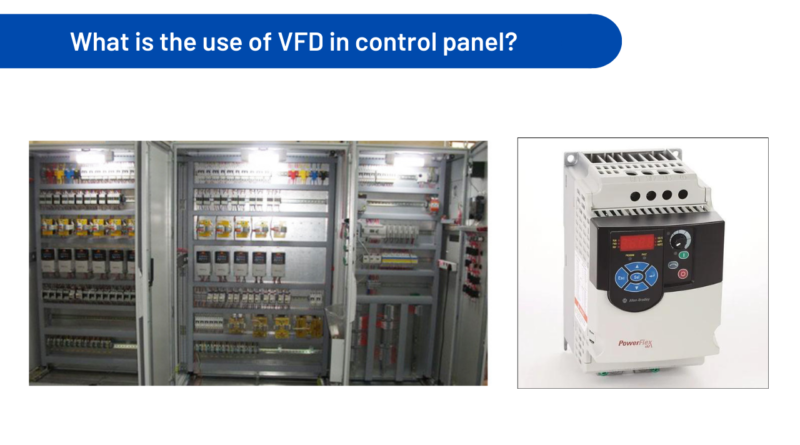What is the use of VFD in control panel?
An electronic device called a Rockwell Automation VFD variable frequency drive, is used in control panels to regulate the speed and torque of electric motors. It is sometimes referred to as an adjustable-speed drive, an AC drive, or an inverter drive.
A VFD’s primary function is to alter the frequency and voltage sent to the motor, which in turn regulates the motor’s rotational speed. A VFD offers various advantages in industrial and commercial applications by modifying the motor’s speed:
Energy efficiency:
With the help of VFDs, motor speed may be precisely controlled, allowing the motor to function at its best under various load scenarios. VFDs can drastically lower energy usage and save money by lowering the motor speed when full speed is not necessary.
- Variable Speed Operation: With the help of VFDs, motors may run at various speeds, allowing them to adapt to the actual demands of the application. Motors do not always need to run at maximum speed in industrial processes. VFDs enable large energy savings by proportionally reducing energy use when speed is decreased.
- Soft Starting: An inrush of power, also referred to as inrush current, is frequently needed for a motor to start. In order to gradually increase the motor’s speed and reduce the inrush current, VFDs offer a soft start option. As a result, there is no longer a need for significant current spikes, and the electrical system is put under less strain, conserving energy.
Process control:
VFDs provide precise speed control, enabling fine-tuning of motor speed in accordance with the particular needs of a process. Conveyor systems, pumps, fans, and compressors are a few examples of applications where this level of control is very useful.
- Speed Regulation: Electric motor speeds may be precisely adjusted and controlled by operators using VFDs. This feature is especially useful in operations where the best performance necessitates precise speeds. VFDs aid in ensuring the stability and dependability of the process by preserving an exact and steady motor speed.
Check :- Allen Bradley PowerFlex 527 AC Drive
Soft starting and stopping:
With the help of VFDs, motors may accelerate and decelerate gradually rather than abruptly, protecting machinery from mechanical stress. This function lessens the need for maintenance and increases the lifespan of motors.
- Reduced Mechanical Stress: Pumps, compressors, and conveyors that are driven by a motor may experience severe mechanical stress if the motor abruptly starts or stops. The smooth ramp-up and ramp-down of motor speed made possible by VFDs’ soft starting and stopping reduces mechanical shock and wear on the system. This decreases the cost of maintenance and helps the device last longer.
- Elimination of Power Surges: High inrush currents that occur during motor start-up can cause voltage drops and other electrical problems in the power supply system. By gradually increasing the motor speed, soft starting lowers the inrush current and has a smaller negative influence on the power grid. This capability is especially useful in places with poor power infrastructure or in buildings with restricted power capacity.
Speed and torque control:
Operators may quickly change the speed and torque output of motors with a VFD, which is advantageous in applications where various operating circumstances or shifting loads must be supported.
- Speed Control: Electric motor rotational speed can be precisely controlled by VFDs. The VFD controls a wide range of motor speeds by varying the frequency and voltage supplied to the motor. By adjusting the motor speed to the particular needs of the application, operators may maximise performance and efficiency.
- Constant Speed Maintenance: VFDs may actively monitor and modify the motor’s speed to offset external variables that may cause speed variations in applications where keeping a consistent speed is essential. The VFD, for instance, may adjust for changes in operating circumstances or variations in load demand to maintain a constant output speed.
Also Read :- Top Dubai Graphic Design Company Creative Solutions
Protection and diagnostics:
VFDs frequently have built-in safety features that keep an eye on motor performance and inform the user or shut the system down in the event of errors like overvoltage, undervoltage, overcurrent, or high temperatures. Additionally, they provide diagnostics capabilities, enabling troubleshooting and routine maintenance.
- Fault Detection and Protection: VFDs keep an eye on a number of variables, including voltage, current, temperature, and motor load, to look for anomalies and potential problems. The VFD can automatically shut down the motor or sound an alarm if any parameter exceeds predetermined thresholds or if a problem is discovered, preventing additional harm to the motor or the equipment it drives.
- Overvoltage and Undervoltage Protection: VFDs keep an eye on the voltage of the incoming power source and safeguard the motor from high or low voltage levels. The VFD can react to overvoltage or undervoltage conditions by immediately cutting off the motor or by starting up safety procedures to stop motor damage.
- Overcurrent Protection: The current going to the motor is continuously monitored by VFDs. The VFD can take action to protect the motor and the attached equipment if the current exceeds safe limits, signalling an overload or short circuit, by slowing down the motor, producing an alarm, or tripping the system.
VFDs are widely utilised in many different industries, including manufacturing, HVAC systems, water treatment plants, and many more because they offer improved motor control, energy efficiency, and operational flexibility.

